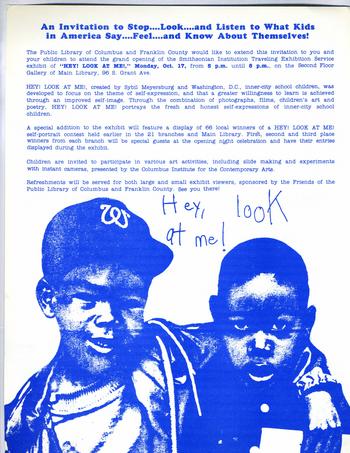 A very common question we get at the Archives starts out, "When I was six years old, I was part of a national art contest and I was told the painting went to the Smithsonian. Since my family and I will be in Washington next week, we'd sure like to see it. Is this possible?" And our answer is, "Well, yes and no. The story may very well be true, but it's a little more complicated than that."
A very common question we get at the Archives starts out, "When I was six years old, I was part of a national art contest and I was told the painting went to the Smithsonian. Since my family and I will be in Washington next week, we'd sure like to see it. Is this possible?" And our answer is, "Well, yes and no. The story may very well be true, but it's a little more complicated than that."
During the late 1950s through the 1970s, teaching the arts and artistic expression was a standard part of school curriculums. At the same time, the Smithsonian Institution Traveling Exhibit Service (SITES – it still exists) was just getting started. In addition to traveling exhibitions of Dutch porcelain and 19th century prints, SITES provided sponsors such as, the Kindergarten Teachers of America, UNICEF, USAID, and others, the means for exhibiting and transporting children’s art around the country. Exhibition files in the Archives' collection, Smithsonian Institution Traveling Exhibition Service, Records, 1952-1981, Record Unit 290, document these small shows.
Usually, the sponsors created the projects, reached out to the children, and gathered the artwork. The Smithsonian then lent its skills in exhibit design, located venues, promoted the exhibits, and shipped them around the country. The partnership between sponsors, sometimes with very limited resources, and the Smithsonian, enabled broad outreach to highlight activities and themes to engage children’s creative side or gain insight into a their worldview.
 Although many of the titles were self explanatory, for instance, American Kindergarten Art (1964) or A Child Looks at the Museum (1958), A Child’s World of Nature (1962), or, Hawaiian Children’s Art (1962); others, are a little harder to decipher, such as, Hey, Look at Me (1976). Many of these shows exposed audiences to the lives and experiences of children very different from themselves. For instance, Hey, Look at Me (1976) captured the voices, poetry, and life of inner-city children in Washington, DC through film and photography.
Although many of the titles were self explanatory, for instance, American Kindergarten Art (1964) or A Child Looks at the Museum (1958), A Child’s World of Nature (1962), or, Hawaiian Children’s Art (1962); others, are a little harder to decipher, such as, Hey, Look at Me (1976). Many of these shows exposed audiences to the lives and experiences of children very different from themselves. For instance, Hey, Look at Me (1976) captured the voices, poetry, and life of inner-city children in Washington, DC through film and photography.
So far, we've answered part of the initial request – exhibits of children's art took place, but what about the artwork? Where did it go and is there any way to find out if the artists are documented at the Smithsonian? Well, this is where it gets a little complicated.
The truth is that there are no vast collections of works on craft paper and tempera paint or crayon at the Smithsonian. That being said, since the art was procured by the instigator of the show, it was likely returned to them after the tour, and what happened after that is not shown in the exhibition files. The exhibition files held in the Archives' collections, however, sometimes have lists of the child artists who were included and even a few photos of pieces in the show (mostly unidentified) for use with press releases. Many of the files also contain itineraries for the tour, promotional brochures, press releases, and newspaper clippings about each exhibit.
So, if you think you were in a show and are interested in finding out about it, do a little homework before getting in touch and we may be able to help find your show. Here are a few research tips:
- How old were you?
- What year do you think this happened?
- What was the theme or what did you draw or paint?
- Was it shown in your hometown? Maybe there was a write-up in the local paper that will name the show.
If you were a kindergarten master of tempera and crayon, perhaps you toured with the Smithsonian. If you think so, do a little research and let us know if we can help.
Produced by the Smithsonian Institution Archives. For copyright questions, please see the Terms of Use.

Leave a Comment